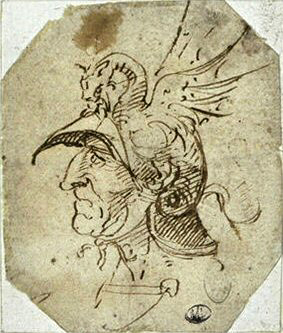Difference between revisions of "Dragon Knight"
Trismegistus (talk | contribs) m |
Trismegistus (talk | contribs) m |
||
| Line 1: | Line 1: | ||
[[File:Michelangelo+CodexVallardiDragonHelmet+15thC+PublicDomain.jpg|thumb|300px|Dragon Knight.]] | [[File:Michelangelo+CodexVallardiDragonHelmet+15thC+PublicDomain.jpg|thumb|300px|Dragon Knight.]] | ||
| − | A dragon knight is an especially trained mounted warrior | + | A dragon knight is an especially trained mounted warrior on the back of a domesticated dragon. The practice of [[dragonmount warfare]] is attributed by strong and longstanding tradition to the ancient [[Neptultchi]]. The art of [[Dragonmount Warfare]] requires the complete and unflinching dedication of the warrior nearly from birth. In many cases, the infant knight is presented to the dragon to determine suitability of the dragon for the human baby. If the dragon shows acceptation, the infant is raised in the presence of the dragon by the dragon women. Historically most dragon knights were male, but this has changed in recent years. The child learns [[Dragonmount Cant]] and they ways of the Dragon Knights. In young childhood, he is required to care for the dragon and learn how to saddle and unsaddle the tack from the beast. As the child approaches young adulthood, he begins his training in earnest, learning to mount and ride the dragon on the ground, until his skill improves enough to take flight. Once he can take flight, his training becomes rigorous and he practices on ground and in the air with other dragon knights, learning to fight as a cohesive group. Historically, Dragon Knights have been forbidden to marry before the age of forty. |
In the past two centuries, dragon knights have adapted measures and skills appropriate for battle with titancraft warfare. Dragon Knights have always been a rare breed and in recent years, there is fear that dragon knights will be completely replaced by titancraft combatants. | In the past two centuries, dragon knights have adapted measures and skills appropriate for battle with titancraft warfare. Dragon Knights have always been a rare breed and in recent years, there is fear that dragon knights will be completely replaced by titancraft combatants. | ||
Revision as of 18:18, 22 October 2014
A dragon knight is an especially trained mounted warrior on the back of a domesticated dragon. The practice of dragonmount warfare is attributed by strong and longstanding tradition to the ancient Neptultchi. The art of Dragonmount Warfare requires the complete and unflinching dedication of the warrior nearly from birth. In many cases, the infant knight is presented to the dragon to determine suitability of the dragon for the human baby. If the dragon shows acceptation, the infant is raised in the presence of the dragon by the dragon women. Historically most dragon knights were male, but this has changed in recent years. The child learns Dragonmount Cant and they ways of the Dragon Knights. In young childhood, he is required to care for the dragon and learn how to saddle and unsaddle the tack from the beast. As the child approaches young adulthood, he begins his training in earnest, learning to mount and ride the dragon on the ground, until his skill improves enough to take flight. Once he can take flight, his training becomes rigorous and he practices on ground and in the air with other dragon knights, learning to fight as a cohesive group. Historically, Dragon Knights have been forbidden to marry before the age of forty.
In the past two centuries, dragon knights have adapted measures and skills appropriate for battle with titancraft warfare. Dragon Knights have always been a rare breed and in recent years, there is fear that dragon knights will be completely replaced by titancraft combatants.
The tradition of Dragon Knights is practiced at the service of rulers throughout southern Pytharnia, including Asbardy, Gonfaloy, Thrain, Ogentir, Magdala, and Medibgö.
Dragon Knights drink the blood of drakelings to fortify their strength on long voyages or before or after a strenuous combat. The amount of blood necessary to benefit a human is relatively small compared to the overall supply of blood in the dragon. The practice of drinking the blood of dragons is deeply troubling to some religionists and is the basis for fearful perceptions and notions about dragon knights. The blood of the dragon is venomous when touched or ingested to most humans and requires a period of habituation. Dragon Knights are habituated to dragon’s blood during the early years of their training as a youth. In ancient times, the open imbibing of dragon blood was used to demonstrate one's valid status as a dragon knight.
In modern times, the practice of tirchaglawchli has spread widely among dragon knight units in southern Pytharnia who are seldom employed in actual warfare. The graceful and intricate maneuvers of tirchaglawchli are appreciated by nobles and commoners and such displays are a special event at state parades.
See Also
| This article is a stub. It requires further development by the creator. |
